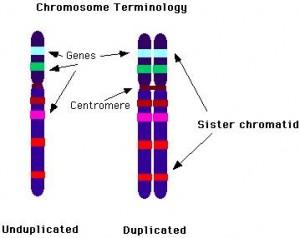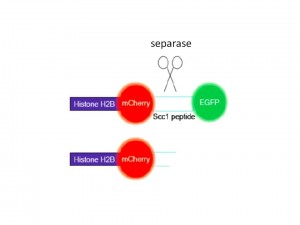Kugako Sugimoto, NOST Tokyo
Originally published on the site of NL Agency.
Summary
Toru Hirota of Japanese Foundation of Cancer Research and his group visualized the activity of the enzyme, separase, that triggers chromosome disjunction by cutting cohesion of sister chromatids. They created a fluorescence-based sensor for separase. They showed how separase worked during a cell division through visual observation of a cell. Since most cancer cells show chromosome instability (CIN) due to the destruction of mechanisms for normal division of sister chromatids, their findings lead to further understanding of the nature of cancer cells and to a new drug discovery targeting separase.
Details
Introduction
When a cell divides, separase, a protease, should cut cohesin (a protein complex to bind chromosomes) and all sister chromatids (Fig. 1) should move polewards in coordination. Mechanisms of how separase is activated and coordination occurs are not understood well. Toru Hirota and his team created separase sensors that visualized activity of separase in a cell. They showed the mechanisms of chromosome disjunction that occurred very quickly and in a good coordination. Their research results were published in ‘Developmental Cell’ on July 16, 2012.
Fig. 1. Sister chromatid and centromere (Paul Decelles, Johnson County Community College)
Method
The separase sensor consisted of a substrate peptide containing a region to be cut by separase, fluorescent proteins, and Histone H2B (or centromere protein B (CENP-B)). Green Fluorescent Protein (GFP) was located at the end of the peptide and a red color fluorophore, mCherry, was located at the other end of peptide (Fig. 2). mCherry was also connected to Histone H2B or CENP-B. These probes were applied to all the regions of the chromosome or only to a centromere. Before being cut by activated separase, the chromosome looks yellow due to mixture of red and green colors. Once the separase was activated and cut the peptide between GFP and mCherry, the color became red because the GFP (green color) was removed. In this way, it has become possible to observe when and where the separase works in a cell.
Fig. 2. separase sensor (Japanese Foundation for Cancer Research)
Results
Separase controlled two important processes. One was cutting the cohesion. Visual observation showed the activity of separase in the metaphase during a period of a decline of securine, an inhibitor of separase was restrained. Activation of separase suddenly boosted up to cut cohesin just before disjunction of chromosomes at the onset of the anaphase. Another was inhibition of the activation of Cdk1 (cyclin-dependent kinase), mediator of cell division, which resulted in facilitation of the poleward movement of sister chromatids to conduct the chromosome disjunction fully.
Meanings
If the function of separase is degraded, cutting the cohesion between sister chromatids and the movement polewards of sister chromatids do not occur correctly. Chromosome instability (CIN) involving gain or loss of whole choromosomes or fractions of chromosomes, is found in most cancer cells and is considered to be responsible for metastasis, infiltration, and becoming malignant of cancer cells. Visualization technique used for quantification of separase activity in one cell contributes to understanding the nature of cancer cells that usually show CIN. In addition, this technique should contribute to creation of new anti-cancer drugs by offering easy screening tools. Since anti-cancer drugs targeting separase have not been developed yet, new addition of a drug would be highly desired.
Source
1) Paper: N Shindo, K Kumada, T Hirota: Separase sensor reveals dual roles for separase coordinating cohesion cleavage and Cdk1 inhibition. Developmental Cell (2012); 23 (1)112-123
2) Press release: Japanese Foundation for Cancer Research
3) Sister chromatids: Wikipedia on sister chromatids
4) Picture of sister chromatids: Basic chromosome terminology by Paul Decelles
5) Cdk1: Wikipedia on Cdk1
6) separase: Wikipedia on separase
7) cohesin: Wikipedia on cohesin









